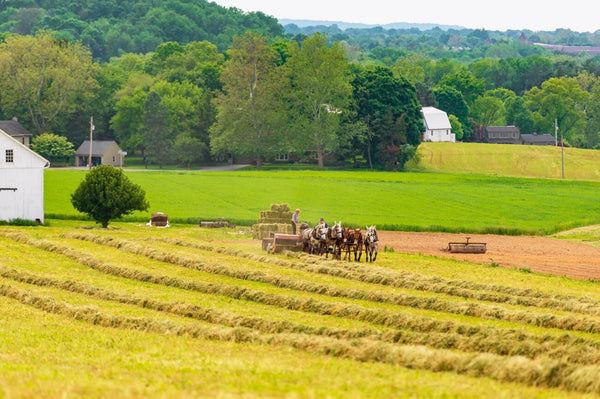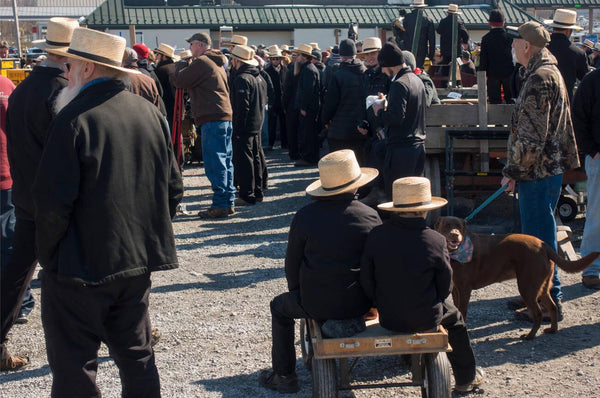We’ve always considered the Amish way of life a fascinating topic, and it’s certainly piqued the interest of many others. It might surprise you to find that the appeal of the Amish lifestyle isn’t hindered by race or ethnic history. One aspect of Amish culture that isn’t widely known is the existence of black Amish communities.
In the same way that some people still ask, “Are Amish people Jewish?” the perceived mystery surrounding black Amish communities stems from a lack of representation in the media and the Amish’s proclivity toward isolation.
In this article, we’ll answer your questions and explore the unique culture and traditions of black Amish communities and showcase the rich art of Amish crafts and goods.
We’re excited to share what we know, so let’s get started!
What this article covers:
- The Origins of Black Amish Communities
- Black Amish Culture and Traditions
- The Rich Art of Amish Crafts and Goods
- Myths and Misconceptions about the Black Amish
- The Importance of Supporting Amish Crafts and Goods
The Origins of Black Amish Communities
Our study shows that black Amish villages date back to when the Amish first came to North America.
One of the critical factors in the development of black Amish communities is interracial marriage. As people from different cultural backgrounds began to join the Amish, their communities became more diverse. This diversity is what led to the unique fusion of traditions we see in the Black Amish today.

You might be wondering about the difference between Amish and Pennsylvania Dutch. Even though these words are often used equally, it’s important to remember that they’re not the same thing.
The Amish are a religious group with their own views and ways of life. The word “Pennsylvania Dutch” refers to a larger culture group that includes the Amish, Mennonites, and other German-speaking people who moved to the United States.
When people decide to join the Amish, they often bring with them their own unique cultural background. This blending of traditions is evident in black Amish communities, where African-American and Amish customs come together to create a truly distinct way of life. In our experience, this rich cultural heritage is part of what makes black Amish communities so special and fascinating to explore.
Black Amish Culture and Traditions
As we learn more about the culture and customs of the Black Amish, it’s important to know how they fit into the larger picture of Amish communities in the United States. Although black Amish communities share many similarities with mainstream Amish culture, they also have some unique aspects that set them apart.
Amish communities in the United States are known for their strong religious beliefs, commitment to simple living, and emphasis on community and family values. These core principles are very much alive in black Amish communities, where faith and togetherness continue to play a crucial role in their way of life.

One of the most striking aspects of black Amish culture is the blending of African-American traditions with Amish customs. This rich fusion is evident in various aspects of their lives, from the foods they prepare to the music they enjoy. This mix of cultures not only makes the black Amish society stronger, but it also shows how different Amish culture is in a new way.
If you look into where the Amish live, you’ll find that there are Black Amish villages all over the U.S.
Some of these communities are in places where Amish people have always lived, like Pennsylvania, Ohio, and Indiana. But you can also find Black Amish families in places you might not expect, like the Deep South or the Pacific Northwest.
From what we’ve seen, the best way to learn more about Amish life in the United States is to understand and appreciate Black Amish culture and customs.
By accepting this variety, we can better understand the rich mix of cultures that make up the Amish group as a whole.
The Rich Art of Amish Crafts and Goods
As we keep learning about the interesting world of black Amish society, it’s hard not to be amazed by the beautiful art of Amish crafts and goods. In black Amish villages, you can find a huge variety of beautiful handmade items that show off the skill and hard work of Amish craftspeople.
One of the most popular items in Amish craftsmanship are wicker baskets for shelves. These intricately woven baskets aren’t just functional but also add a touch of rustic charm to any home. Another must-have item in any Amish craft collection is the vintage wicker laundry basket. These baskets, with their sturdy construction and timeless design, have been a staple in Amish households for generations.
In black Amish communities, you might find subtle variations in color or pattern, reflecting the community’s distinct cultural influences.
When it comes to enjoying the great outdoors, nothing beats a wooden picnic basket handcrafted by Amish artisans. These baskets, often made from durable wood and featuring intricate carvings, are perfect for a leisurely afternoon spent with family and friends. In black Amish communities, the blend of Amish and African-American traditions gives these wooden picnic baskets a truly unique flair.
In our experience, the rich art of Amish crafts and goods is a testament to the creativity and dedication of Black Amish artisans. Their work not only enriches our lives but also helps preserve the unique traditions and customs that make black Amish communities so special.
At Amish Baskets, we are proud to show off the work of all Amish artists and to offer our customers a wide range of high-quality Amish crafts and goods.
Myths and Misconceptions about the Black Amish
As we learn more about the interesting world of Black Amish society, it’s important to clear up some of the common myths and misunderstandings about these communities. By clarifying these misunderstandings, we can foster a better understanding and appreciation of Black Amish culture and traditions.
Myth #1 – Black Amish communities are separate from traditional Amish communities
While Black Amish communities may have their distinct cultural elements, they’re still very much a part of the broader Amish community. They share core religious beliefs, values, and practices with other Amish groups, and often interact and collaborate with one another.

Myth #2 – Black Amish culture is completely different from mainstream Amish culture
Although Black Amish communities incorporate aspects of African-American traditions into their way of life, their culture remains firmly rooted in Amish values and customs. The blending of traditions enriches the overall Amish experience, showcasing the diversity within the Amish community.
Myth #2 – Black Amish communities are only found in specific geographic locations
Black Amish villages can be found all over the United States, from traditional Amish strongholds like Pennsylvania and Ohio to more unexpected places like the Deep South or the Pacific Northwest.
Myth #3 – The Amish don’t accept people from diverse backgrounds.
While the Amish are known for their conservative beliefs, they’re also open to welcoming individuals from different cultural backgrounds who wish to join their community. This openness has led to the development of diverse communities like the Black Amish, where unique cultural elements are embraced and celebrated.
By debunking these myths and misconceptions, we can develop a more accurate understanding of Black Amish communities and the broader Amish culture. In our experience, fostering this understanding helps us appreciate the diverse traditions and customs that make the Amish community so rich and fascinating.
The Importance of Supporting Amish Crafts and Goods
As we learn more about the unique culture and traditions of black Amish communities, it becomes clear just how vital it is to support Amish crafts and goods. By purchasing items like extra large sewing baskets or wooden bread boxes, we not only bring beauty and functionality into our homes but also help preserve the rich heritage of Amish craftsmanship.
“Can you become Amish if you have tattoos?” is a question that comes up a lot when people talk about Amish society. Even though the Amish are known for being very traditional, they also know that people have different backgrounds and experiences. It’s entirely possible for someone with tattoos to join the Amish community if they make a genuine commitment to embracing the Amish way of life.
By supporting Amish crafts and goods, we contribute to the preservation and growth of Amish culture, including the unique traditions found in black Amish communities. Our purchases not only support talented artisans but also help to foster understanding and appreciation for the diverse range of customs and beliefs that make up the Amish community.
Conclusion
In conclusion, black Amish communities offer a unique and fascinating glimpse into the diversity of Amish culture and traditions.
In our opinion, Amish culture has never been as limiting or as closed-off as pop culture would have you believe. Their beliefs don’t stem from a desire to exclude. If anything, having more people accept their way of life is something to celebrate!
Did You Find Our Blog Helpful? Then Consider Checking:
- Do Amish Go to School
- Amish Education
- Do Amish Pay Taxes
- Do Amish Have Social Security Numbers
- Do Amish Celebrate Birthdays
- Amish Games
- Do Amish Have Mirrors
- Amish Adoption
- Do Amish Vote for President
- Do Amish Stand for the National Anthem
- Do Amish Receive Stimulus Checks
- Do Amish Go to Doctors
- Amish Health Secrets
- Amish Healthcare
- How Do the Amish Keep Food Cold




